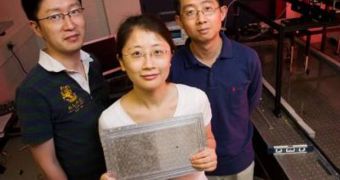Experts at the University of Illinois have just created a new type of acoustic metamaterial, which can pave the way for applications such as better ultrasound scans, non-invasive building risk assessment, structural integrity testings, and new types of underwater stealth technologies.
UI Professor of Mechanical Science and Engineering Nicholas X. Fang led a team of colleagues that successfully managed to convert ultrasounds through the new “superlens,” on a tiny spot shorter than the width of a wavelength at 60.5 kHz. For the job, the experts used what is known as a fluid-filled Helmholtz resonators network, which acted like the focusing medium. Fang likens the obtained system to an inductor-capacitor circuit. Details of the achievement are published in the May 15th issue of the scientific journal Physical Review Letters.
The find could have a large number of uses in areas where light is considered to be simply too intrusive to be used. For instance, optically imaging the womb of a pregnant woman may not prove to be such a good idea, but, on the other hand, existing imaging techniques may not be as sharp as an optical image either. But still, creating an image from sounds remains the safest method of ensuring that human beings are not harmed during testing.
“With acoustic imaging, you can't see anything that's smaller than a few millimeters. The image resolution is getting better and better, but it's still not as convenient or accurate as optical imaging,” Fang explains. He adds that exposure to the most commonly used form of optical investigation, X-ray radiation, is a health risk, if performed several times per year, and that exposing patients to this risk may soon become a thing of the past.
“If we wish to detect or screen early stage tumors in the human body using acoustic imaging, then better resolution and higher contrast are equally important. In the body, tumors are often surrounded by hard tissues with high contrast, so you can't see them clearly, and acoustic imaging may provide more details than optical imaging methods,” Fang adds.
“Acoustic imaging is a different means of detecting and probing things, beyond optical imaging. Right now, the goal is to bring this 'lab science' out of the lab and create a practical device or system that will allow us to use acoustic imaging in a variety of situations,” he concludes.

 14 DAY TRIAL //
14 DAY TRIAL //